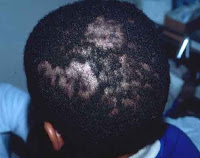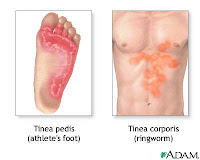Fungi of this family cause infections on the skin, nails and scalp and they constitute over 50% within 55 species of fungus considered to be pathogenic for humans and animals. The lesions caused by dermatophytes are usually circular and tend to enlarge equally in all directions. These fungi usually affect the superficial keratin-rich layer of the affected areas. They hydrolyze our keratin protein and can survive even in the absence of keratin (this is an extremely slow process). In the past it was thought that these infections were caused by worms or lice and therefore the names of the diseases: ringworm or tinea. The complimenting suffix was further qualified by the name of the body area affected( tinea capitis - ringworm of the scalp, tinea pedis - athlete's foot etc. ). There are three pathogenic genera of Dermatophytes - Microsporum, Trichophyton and Epidermophyton. Tinea capitis:
It is caused by species of Microsporum and Trichophyton. The disease varies from small itching on the scalp to severe cases which can cause permanent baldness. Some of the infections can result in painful inflammations and pustular abcesses around the hair follicles.
The disease is 'sometimes' highly contagious (varies depending on the life cycle of the fungi) transmitted either directly or via hair clippers and other fomites (Def: any inanimate object or substance capable of carrying infectious organisms such as germs or parasites). Tinea capitis is seen in two forms: endothrix infections, with the hyphae growing only within the hair and ectothrix infections, with growth within and on the surface of the hair shaft.
Tinea corporis:This is the disease more commonly known as ringworm of the smooth skin. The lesions are usually circular with a scaly center, surrounded by an advancing circle of vesicles and papules.The lesions may itch, particularly in warm weather. Tinea corporis is caused by species of Microsporum and Trichophyton.
Tinea barbae:
More commonly known as `barber's itch' affects the bearded area of the face and neck, forming dark red abcessess. The hairs in the affected areas become brittle and lack luster. It is caused by members of Trichophyton and more rarely Microsporum.
Tinea capitis:
It is caused by species of Microsporum and Trichophyton. The disease varies from small itching on the scalp to severe cases which can cause permanent baldness. Some of the infections can result in painful inflammations and pustular abcesses around the hair follicles.
The disease is 'sometimes' highly contagious (varies depending on the life cycle of the fungi) transmitted either directly or via hair clippers and other fomites (Def: any inanimate object or substance capable of carrying infectious organisms such as germs or parasites). Tinea capitis is seen in two forms: endothrix infections, with the hyphae growing only within the hair and ectothrix infections, with growth within and on the surface of the hair shaft.
Tinea corporis:This is the disease more commonly known as ringworm of the smooth skin. The lesions are usually circular with a scaly center, surrounded by an advancing circle of vesicles and papules.The lesions may itch, particularly in warm weather. Tinea corporis is caused by species of Microsporum and Trichophyton.
Tinea barbae:
More commonly known as `barber's itch' affects the bearded area of the face and neck, forming dark red abcessess. The hairs in the affected areas become brittle and lack luster. It is caused by members of Trichophyton and more rarely Microsporum.
Tinea Cruris:Reference: J Dermatology 2008 Aug;35(8):541-5:Title: Unusual presentation of tinea cruris due to Trichophyton mentagrophytes var. mentagrophytes.
Location: Mycology Research Center, Faculty of Veterinary Medicine, University of Tehran, Tehran, Iran.
Contact:
khosravi@ut.ac.irAbstract: Tinea cruris is a subacute or chronic dermatophytosis. This report describes a 30-year-old man presenting with a history of bullous erythematous along with itching of his crural (thigh) region. This is commonly known in the North America as jock itch (fungal groin infection).
On the basis of clinical findings, the lesions were mis-diagnosed as contact dermatitis and pustular psoriasis, so he was treated by local and systemic corticosteroids but pustular lesions were progressed on the affected sites. By using mycological and histological examinations, dermatophytosis caused by Trichophyton mentagrophytes var. mentagrophytes was confirmed. The patient was successfully treated with itraconazole and local antifungal treatments.
Tinea Eyebrows:
Reference: Cutis 1991 Aug;48(2):149-50.
Title: Tinea of the eyebrow showing kerion celsi reaction: report of one case.Location: Department of Dermatology, National Defense Medical College, Saitama, Japan.
Contact: Hiruma, M.Abstract: A case of dermatophytosis showing a kerion celsi reaction in the eyebrow of a forty-seven-year-old woman is reported. The causative organism was Trichophyton rubrum. Direct mycologic examination revealed endothrix parasitism within the shafts of the infected hairs, and the trichophytin test gave positive results. Histologic examination of the lesion revealed marked inflammatory infiltration in the dermis, and numerous arthroconidia within the hair shafts. The symptoms disappeared almost entirely after oral treatment with itraconazole for three weeks. In view of the rarity of tinea of the eyebrow ... Tinea pedis:
Athlete's foot (common name) is the most common fungus infection , most of the cases being caused by Trichophyton mentagrophytes. It results in an inflammatory infection with vesicles between the toes and on the soles; the skin peels and fissures form in the affected areas. The infection can sometimes spread to hands,thighs and other areas.
Tinea unguium:This sometimes called onychomycosis or ringworm of the nails. The nails become opaque and brittle, lose luster and are easily separated from the nail bed. The infection is caused by Epidermophyton floccosum or various species of Trichophyton.
Tinea pedis:
Athlete's foot (common name) is the most common fungus infection , most of the cases being caused by Trichophyton mentagrophytes. It results in an inflammatory infection with vesicles between the toes and on the soles; the skin peels and fissures form in the affected areas. The infection can sometimes spread to hands,thighs and other areas.
Tinea unguium:This sometimes called onychomycosis or ringworm of the nails. The nails become opaque and brittle, lose luster and are easily separated from the nail bed. The infection is caused by Epidermophyton floccosum or various species of Trichophyton.
Treatment options: Most failures of topical therapy are either due to inaccurate diagnosis, inadequate treatment, missing out some lesions or re-infection either auto-infection (fomite recontamination) or from other sources (pet-to-human, human-to-human).
Historical usages:
Oral Itraconazole used in a single dose of 400 mg and ketoconazole total adult dose 800-1000mg is common protocol. Children are given smaller doses depending on their weight.
The value of oral treatment with 400 mg. of Fluconazole (tradename: DIFLUCAN) in a single adult dose proved to be effective in the treatment of pityriasis versicolor.
These medications are expensive and some patients can not afford the cost. Oral azoles such as itraconazole, ketoconazole, ecanazole and fluconazole have toxicities, teratogenic effects and should be used under careful guidance of BOTH a qualified microbiologist and physician.
The use of creams, spray and shampoos containing the formulation ratio:
10% artemesia oil (wormwood)
5% neem oil
15% tea tree oil
20% thorn tree oil
10% aquarius superwash (contains supermatrix)
40% deionized water
has been found to be highly effective against treating dermatophytes. This can be used to rub the skin twice daily for one month and later once weekly for three months or for longer periods.
All fomites (pillows, hairdryers, slippers, clothing, nail clippers etc) and pets, pet equipment should also be washed with the given formula.
Formulation is currently being produced by http://www.surewit-hk.com/
要盡心, 盡性, 盡意, 盡力愛主你的神 和愛人如己(Luke 10:27 NIV Bible) Dr. Gordon & Yourself: Solutions Together http://www.gordonyourself.com. GY BLOG via AnD/google is the